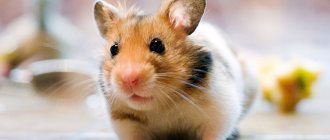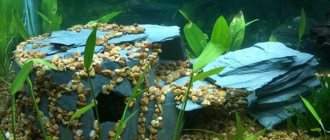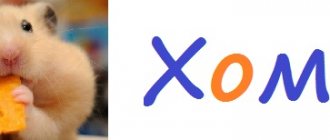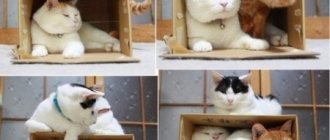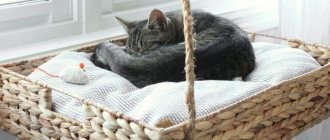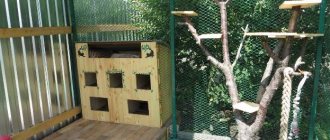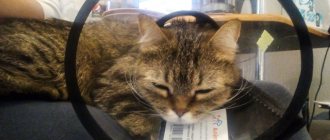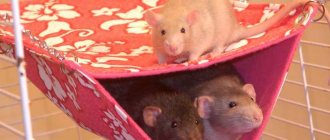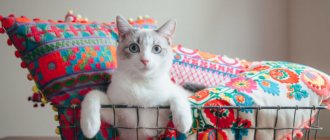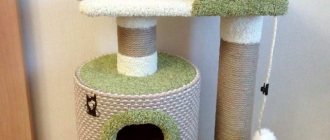- home
- Parrot
- Arrangement
04/13/2019 Budgerigars that live in the wild look for old trees with convenient hollows to build their nests. Having chosen the tree you like, they thoroughly clean the future breeding house of debris and even trample down the wood dust at the bottom. Birds choose places where they will feel safe during the nesting period.
In captivity, their owners help them settle in. What a comfortable nesting house for budgerigars should be like is described in this article.
Types of nesting houses
There is no need for parrot owners to go into the forest to find a littered, dried tree with a large hollow. A parrot house, practical and safe, can be purchased ready-made or made by yourself.
The choice is between rectangular structures, which differ in the ratio of width, length and height. Each option has its own advantages and disadvantages. The common feature is wood as a material for production and the size of the hole is approximately 50 mm in diameter. The female will be able to expand the cage if necessary. She uses her beak, which she uses to bite off excess wood.
Horizontal design
A parrot house with a width and length of 20x25 cm and a height of 15 cm is called horizontal. The site is quite spacious. It is convenient for the female to hatch eggs and climb into the house without damaging the clutch.
The downside is the following: the height of the house is small, the entrance hole is located very low. Still immature chicks can fall out.
Vertical design
A house with a width and length of 20 cm, a height of 25 cm is called vertical. Little chicks will not get out of the nest ahead of time. But the exit from the house is located at a high altitude. If the female climbs into it carelessly, there is a risk of crushing the eggs or chicks that hatch last.
Compromise option
A compromise solution is the size of the house 25x20 cm, 20 cm high. The area is sufficient for the female to move around. Small parrots will not have the opportunity to accidentally crawl out. A step, which is made at the bottom under a 6x3 cm perch, helps the female to safely settle on the clutch. The chicks will be safe.
Arrangement
To make it easier for the female to move and make it easier to fly in and out, a wooden plank 3 to 5 cm high should be nailed to the bottom under the entrance hole from the inside (this step occupies a third of the bottom).
It is important to line the floor with bedding because a smooth surface will cause the eggs to roll out into the corners. To do this, special materials are used that help retain heat; it is advisable to use natural raw materials, such as sawdust mixed with dried chamomile. This bedding also helps protect offspring and birds from parasites. It is enough to make a layer up to 2 centimeters.
During nesting, it is not recommended to clean the nest or change sawdust, so as not to disturb the feathered mother.
How to make a nesting house?
The design of the nesting house is simple, you need a minimum of materials, the most basic tools. You can use improvised means. The main thing is to have the desire to make a nest for budgies with your own hands.
What materials will be needed?
Materials for making a house must meet the following requirements:
- environmental friendliness and safety for the feathered family;
- the ability to carry out disinfection if necessary.
The best option is wood. You can remake the simplest apple box. It is easy to make a structure from plywood. It's better not to take chipboard. A small house made of particle board will be heated by birds and emit harmful fumes. In addition, birds can peck at shavings that are treated with an adhesive composition. Making a house from MDF is not the best solution, since parrots are capable of pecking at such material.
In addition to wood for the walls, bottom and roof, you should prepare:
- wooden stick-perch;
- nails or screws;
- roof hinges.
What tool will you need?
If you plan to use nails to knock together the walls, you will need a hammer. Some craftsmen prefer to use self-tapping screws. In this case, you need a Phillips screwdriver or screwdriver. To take measurements, you will need a ruler or tape measure, pen or pencil.
A round hole for birds is marked using a compass and cut out by hand with a hacksaw with a very narrow blade, a drill saw or a round file. It is most convenient to do these manipulations with a jigsaw or electric hacksaw.
Design and manufacturing
Before you start making a nest for a parrot, you need to decide on its size. If the choice falls on compromise dimensions, you need to prepare templates of the following sizes from paper or cardboard:
- 25x20 cm for two side walls.
- 20X20 cm for the front and back walls.
- 20x25 cm for floor and roof.
Using cardboard templates, cut out plywood parts. You should have 4 walls, a roof and a bottom. The roof is placed on hinges, which are attached immediately. The bottom of the cage should be as close as possible to the nest structure that parrots make in nature. This can be achieved by cutting a circle into the bottom with a jigsaw. From another piece you need to cut a circle with a slightly larger diameter and attach it to the back of the bottom. In this way, a nest with a recess is obtained.
The walls are connected using nails or self-tapping screws. The roof is attached to vent or piano hinges. A taphole is cut out on the façade wall, having previously marked a circle using a compass. A hole is made under it for a perch. It should extend 30 mm inside and protrude 100 mm outside. These parameters are enough for the female to comfortably climb inside.
Holes for ventilation with a diameter of up to 1 cm are made on the side walls. This is very important for birds, otherwise small chicks may suffocate and the female will have difficulty breathing. Larger holes should not be made to prevent the chicks from getting cold.
Making a parrot's nest is easier than it seems at first glance. If you have the necessary tools and materials, the entire process will take no more than 2–3 hours.
How to arrange a nest?
The nesting house is washed and scalded with boiling water. When it dries, you can begin arrangement. In the wild, the female makes a depression at the bottom of the hollow. Trash and other debris in the form of slivers of feathers and droppings left over from previous birds are thrown out of the nest by the female. But very fine wood dust remains, which removes the hardness of the bottom and serves as thermal insulation.
In captivity the situation is different from the conditions in the wild. Even if you make a hole in a plywood box, this does not guarantee comfort for the birds. Most breeders believe that the best solution is to use sawdust for bedding.
There is no need to install heating devices in the house. The female will cope with heating the offspring on her own. If for some reason the room is very cold, an incandescent lamp can be placed close to the cage, at a safe distance from the birds.
Nest for budgies: buy or make it yourself?
Before a pair of wavy birds gets ready to breed, you need to make a nest, it is also called a nesting house. This is an important stimulus for the female to lay eggs.
Nesting houses are usually divided into vertical (imagine a kind of narrow mini-birdhouse), horizontal (the principle is the same, only instead of height the house is stretched in width), and a mixed type (the so-called compromise house).
The mixed type combines sufficient width and a high entrance for the female (entry). Thus, in such a nest the disadvantages of the two previous types of nest are solved, and here:
- it is difficult for parrots to fall out or jump out in the first days of life, which means they will be healthier
- the female will not crush the chicks by flying into the house, since the entrance is high above the chicks
- due to its large width, the nesting area is spacious for the female and offspring
How to use sawdust?
The female has an instinct to clean the nest before settling into it. Therefore, as soon as the house is installed, she will conduct an “audit”.
To prevent the female from immediately throwing sawdust out of the nest, add a small amount of it. Fine sawdust is mixed with a pinch of dry chamomile to prevent ticks. You can completely replace sawdust with crushed chamomile.
Subsequently, when the chicks begin to hatch, larger sawdust can be placed in the parrots’ nest. Parrots will grab them with their paws and train them. The number of helicopter pilots will decrease.
The sawdust will keep the chicks warm and safe. Breeders do not limit the choice of wood type for sawdust.
What are the pros and cons of a pet store house?
The nest for a budgerigar should be suitable for the female and chicks. But this doesn't always happen.
A nesting house purchased at a pet store is made of chipboard material, which is harmful to birds. Wooden nests are available, but they are very expensive.
Shop houses are not knocked down or twisted with screws, but glued together. The adhesive mixture is unknown. There is no guarantee that dangerous fumes will not be released.
The thickness of the walls and floors in a purchased house rarely exceeds 10 mm. It will be difficult for the female to warm the clutch, and the hatched chicks will be cold.
Ready-made models
You can purchase or order a special nesting house in the store. Such models are already equipped with metal hooks, most of them have all the necessary parameters, are safe, equipped with hinged lids, perches, and convenient entry. There are models made from natural coconuts, wood, dried meadow grass stalks, plastic, metal rods, and fabric. The assortment is very large and varied, sometimes it is easier to buy a ready-made option than to make a nest with your own hands.
What are the pros and cons of a custom nesting house?
When the owner of the parrots does not have the desire or time to deal with making a house on his own, it is better to order it.
Advantages of this solution:
- the client’s wishes are taken into account;
- production time is discussed;
- The workmanship is usually excellent.
Difficulties that may arise:
- it is impossible to find craftsmen;
- long production time;
- high price for work.
These disadvantages are not always present. Craftsmen can be found on the Internet or in the nearest carpentry shop, and they can negotiate at a reasonable price. Conscientious craftsmen fulfill orders quickly and efficiently.
When and where to place a nest?
The mating season of domestic budgerigars does not depend on the season, as in the wild. In Australia, these birds breed in the summer, when nature has the optimal amount of nutritious and vitamin-rich food. At home, the optimal temperature and appropriate feed depend on the breeder.
If you plan to breed parrots, the diet is enriched with food containing vitamins E and D. Do not forget to place a mineral stone (chalk) in the cage as the birds eat it. Daylight hours should be at least 15 hours. Sometimes additional lighting is required. The temperature in the room is not lower than +15℃.
The fact that the nesting of budgerigars is just around the corner and it’s time to build a house is indicated by the beginning of mating games in a pair of different-sex parrots. At this time, the male persistently courts his girlfriend, who does not reject the advances. Birds may begin to pluck each other’s feathers, “coo” among themselves for a long time, and kiss. The parrot begins to knock on all hard objects in the cage, on the female’s beak, and nod its head. He brings his friend treats, she accepts them.
There are such couples when during the mating season the female does not eat anything until her friend brings her a treat. As soon as a nest is installed in the cage, the female, ready to breed offspring, will begin to inhabit it.
Experienced breeders believe that serious couples should not delay installing a house. Expectant parents need to be sure that they have a place to hatch and feed their babies.
The house is fixed outside the cage or placed inside. The first option is suitable for small cell areas due to space saving. The parrots themselves will like it better if the nest is installed inside. This way the female will be calmer. The male often settles on the roof, and the female hears it.
The cage can have any shape, but it must be spacious. A prerequisite is a removable roof. Otherwise, it will not be possible to keep the nest clean and disinfect the home. The steel bars of the cage must be quite strong and thick to securely fix the house.
The entire structure should be in a warm room. Dampness and drafts are unacceptable. During the period when the female sits on the clutch, and also subsequently when feeding occurs, the birds need peace and quiet. If the room is noisy, the couple will be disturbed, and they may abandon the chicks.
Smoking in the room where budgies are located is prohibited. This applies not only to the period when they breed. Birds cannot tolerate tobacco smoke.
DIY parrot toy
Accessories that are presented in pet stores are not always made of high-quality materials. Knowing how to make a toy for a parrot with your own hands, you can make an interesting item that will be safe for your pet.
Swing
Birds really like colorful swings. You can use materials from scrap materials to make toys for parrots with your own hands. To make the accessory you will need: a perch, beads, wire.
We recommend reading: How to teach your parrot to talk
A triangular base is made from wire. Its length is calculated based on the size of the bird. It should fit freely inside the toy. It is also necessary to leave a few centimeters for fastening. Holes are made in the wooden base with which it will be attached to the base. Bright decorative elements are placed on the wire. The ends of the wire are attached to a wooden element. Then the beads are placed on the base. To place it on the cage, a ring is made at the top of the swing.
Bells
One of the favorite toys of birds is a bell. It can be hung separately in a cage or used as part of an accessory. Let's take a closer look at how to make a bungee toy for a parrot with your own hands. It can be made from the following elements: half a centimeter thick rope, a metal bell, a twig and beads. Knots are made on the rope, alternating them with beads. A perch and a bell are attached to the bottom, and the upper part is tied to the roof of the pet’s home.
Ladders
Birds like to climb stairs. You can make such toys for parrots with your own hands from wooden perches and rope. Sticks of the same length are prepared from tree species that are safe for birds. Branches of bird cherry, oak, pear or poplar are not suitable. Closer to the ends of the poles, small indentations are made for better fixation of the rope. The wooden elements are sanded and then tied together to form a ladder.
Rattles
As a toy for your pet, you can use multi-colored rattles left over from an older child. The teething rattle will be of particular interest because this accessory has an uneven surface. You can decorate it with knots and bright beads.
When thinking about how to make a toy for a parrot with your own hands at home, you should pay attention to the items that are at hand. You can use a plastic container from a Kinder Surprise as a base.
Buttons and beads are placed in it. Small holes are made in the base to prevent small elements from spilling out.
Nest house care
The first cleaning is planned when the chicks are two weeks old. The lid must be opened and the chicks quickly and carefully removed from the nest and placed in a prepared cardboard box. Egg shells and droppings are removed from the nest and the bedding is changed.
When the chicks leave the house, they are disinfected. Chemicals and chlorine-containing preparations cannot be used. It is enough to scald a wooden house with boiling water. If there is a need to use detergents, these can be baby soap, laundry soap and baking soda.
Cleaning is done weekly. If the birds have a very negative attitude towards this process, it is better to leave them alone. Such a stressful situation will not lead to anything good.
If the couple has trust in the owner, they are not aggressive, and they clean regularly. The birds are allowed to fly around the room, the babies are seated. Even if the parrots are loyal to this process, this must be done quickly, without abusing the patience of the couple.
Hatching chicks
Typically, the female lays 5 eggs. It is advisable not to disturb the birds during this period; you need to clean the cage very carefully. At first, the female may leave the nest frequently, but later this becomes much less common. Not all chicks hatch; some lack moisture or oxygen and die. The cause of death may be too high a temperature when hatching in the summer. To avoid this, you can make holes in the bottom of the nesting box and spray the nesting with water. The parrot warms the eggs with its body. The female turns them over and moves them twice a day. This is done in order to heat evenly.
After about a week, it will be possible to determine which eggs are fertilized. As a rule, they are matte and have a gray-white color. If you look at the light, you will see a thin web of blood vessels. Unfertilized eggs may be yellow, spotted, or shiny. They can be removed from the lovebird nest only if the clutch is large. If it is small, then they should be left. They only protect the hatched chicks from harm.
Sometimes during the first nesting it happens that all the eggs are unfertilized. In this case, they do not need to be removed from the nest. It is necessary to allow the bird to sit for the entire period, since the breeding rhythm may be disrupted. After this, the bird will begin a second clutch. You can replace several unfertilized eggs from other nests if you have several pairs of lovebirds.
It very rarely happens that a bird eats its own eggs. Then you need to make a double bottom in the nesting area. You need to make a hole in one of them so that the laid eggs fall down. The main thing is to make a soft bedding from hay, sawdust, and cotton wool. Then these eggs can be placed on another female to hatch.

